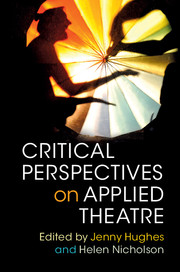1 - Applied theatre: ecology of practices
Published online by Cambridge University Press: 05 April 2016
Summary
At high tide on the Thames on 13 June 2015 at 11.53 am a group of art activists began an unsanctioned twenty-five hour durational performance in the expansive Turbine Hall at Tate Modern, a large art gallery on the gentrified South Bank in London. Entitled Time Piece, this was the latest in a series of interventions by Liberate Tate, an art collective who stage performative protests against the oil industry's sponsorship of cultural organisations. Described as a ‘textual intervention’, seventy-five performers used charcoal to inscribe the concrete floor with passages and quotations from dystopian novels, environmental reports, slogans and non-fictional works about art, climate change and fossil fuel. Each performer scribbled silently, veiled and dressed in black, and when the gallery closed at 10 pm, twenty activists continued their carefully choreographed work through the night, unimpeded by security guards or the police. By morning, when Tate Modern re-opened its doors, the Turbine Hall remained closed to visitors. When the tide turned at 12.55 pm on 14 June, the performers left and the cleaning staff moved in.
We begin with this performative protest not because it is representative of all applied theatre, but because its concerns resonate with many of the ideas explored in this book. As a piece of activist art, Time Piece both invokes a long history of performative protest and also captures contemporary anxieties about the relationship between climate change, global capitalism, neoliberalism and the arts, all of which are debated by authors in this book. Beyond the substance of its environmental message, the performance illuminates deeper cultural responses to the contemporary landscape that are also articulated in this collection of essays. Time Piece re-imagined synergies between time and the material world, recognising that temporality is experienced in multiple ways. Liberate Tate capture this impulse on their website, describing how Time Piece draws attention to the different temporal registers that affect lives as ‘lunar time, tidal time, ecological time, geological time and all the ways in which we are running out of time’. The hunched figures dressed in black veils, quietly creating a rising tide of words on the floor, were like mourners marking a space by inscribing its relationship to lost time, a performative memorialisation of material life destroyed by practices of industrial excavation and economic exploitation driven by fossil fuel economies.
- Type
- Chapter
- Information
- Critical Perspectives on Applied Theatre , pp. 1 - 12Publisher: Cambridge University PressPrint publication year: 2016
References
- 4
- Cited by



